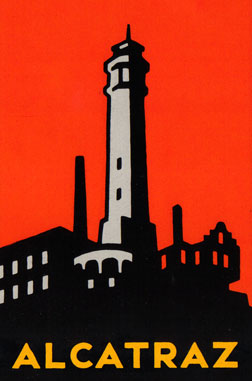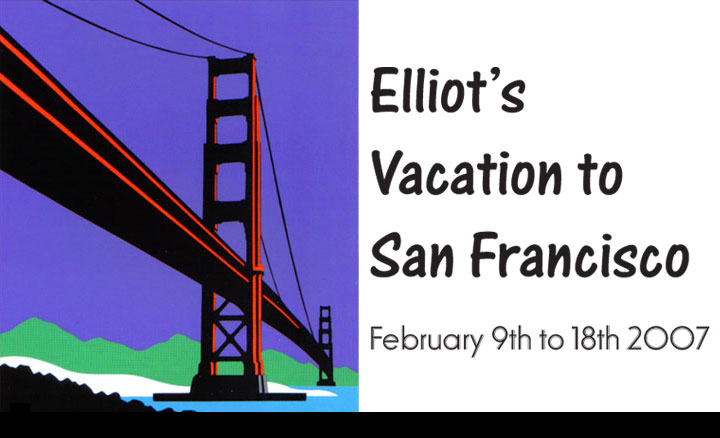


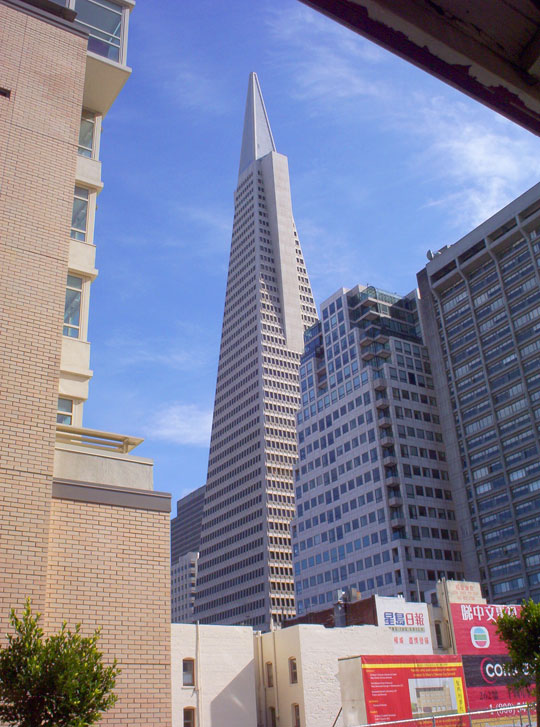
Travel:
My father and I flew in Portland, Oregon so we could visit our my Brother Nick, his wife Dana, and my nephew Cameron. Depending on the flights, it takes as little as 7.5 hours to as much as 10 hours to get to Portland. The good thing is that Portland is not exactly a tourism mecca and so flights are very cheap.
After spending a bit of time in Portland, we borrowed Nicks car and drove the 650 miles to San Francisco along Interstate 5. From Portland to San Francisco interstate 5 was a superhighway. We left at 8am and could have made in to San Francisco for 6:30 that night. However it was poring rain so we decided to stop just outside of the city. The next morning we drove into San Francisco without having to race.
Day 1:
Since we arrived in the city in the morning hours, we decided to take a city tour. After all, we had to wait until the early afternoon to check in to the hotel.
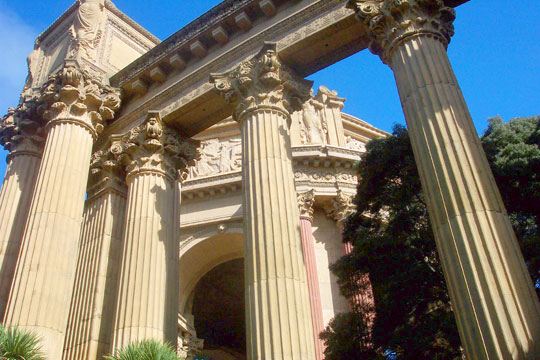
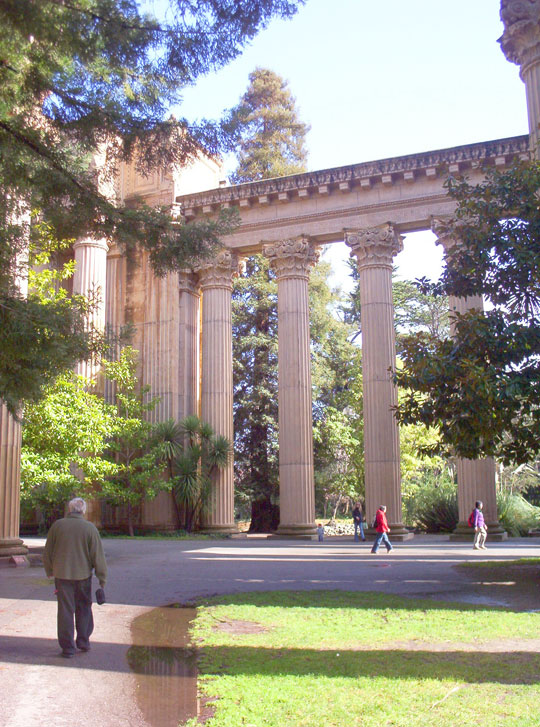
The first stop was at the famed Palace of Fine arts. Built in 1915 for the worlds-fair the palace was only designed to last a few years. By the 1960's it was in ruins so the city decided to reconstruct it using proper building techniques. Today it is a public park / museum. |
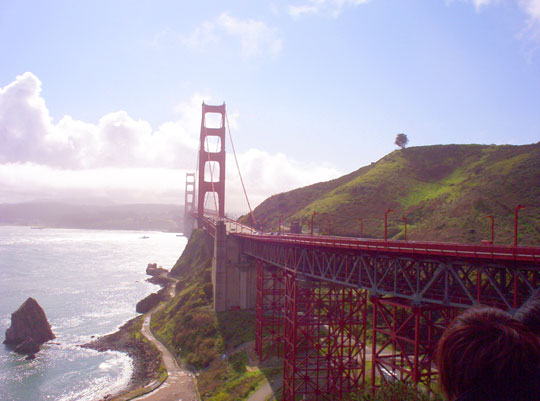
Then it was across the Golden Gate
Bridge |
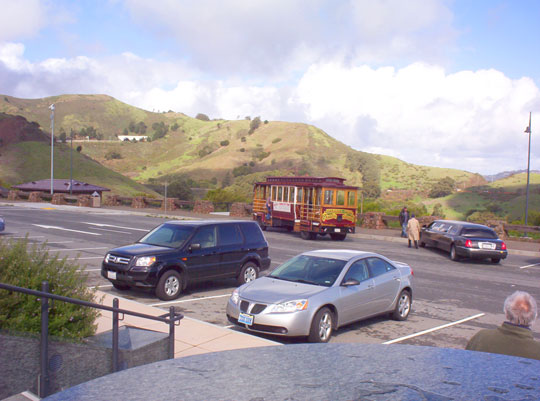
The tour was given in a "motorized street car", similar to those you find on International drive. Then it was to the Presidio, an old military Base now a public park. These houses rent for $5000 a month and include 2 bedrooms, 2 bathrooms and a "working fireplace". |
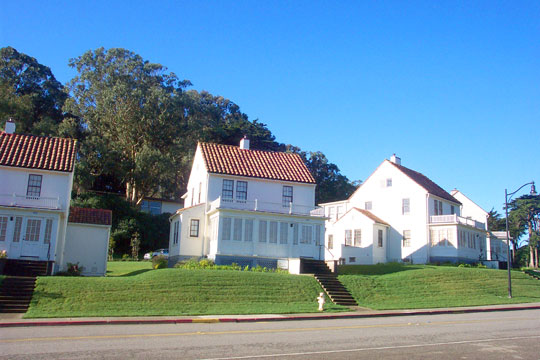
The tour then drove throughout the city and included some of the key San Francisco tourist attractions. Afterwards we checked into our hotel and decided to explore the city on foot. |
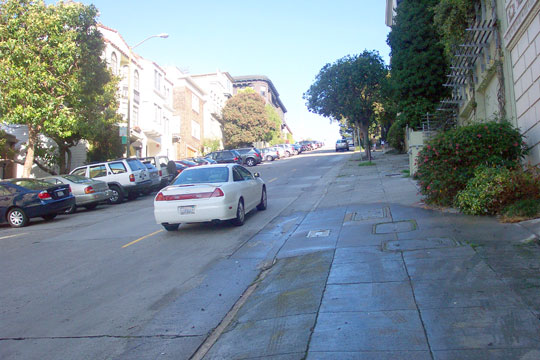
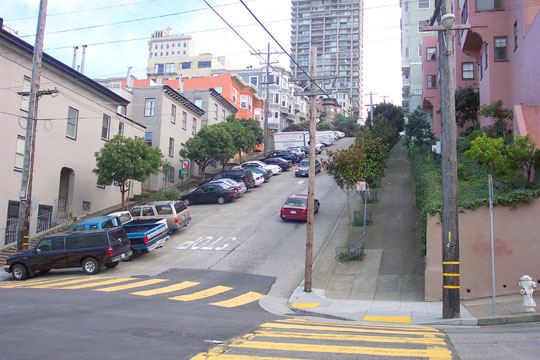
A challenge for any pedestrian, the streets of San Francisco are rather steep. In many places they have stairs rather than sidewalks. At Fisherman's Warf (the one flat part of the city) we saw Harbor seals, actual fishing boats, and fresh catch of the day. Crabs are still alive when cooked. |
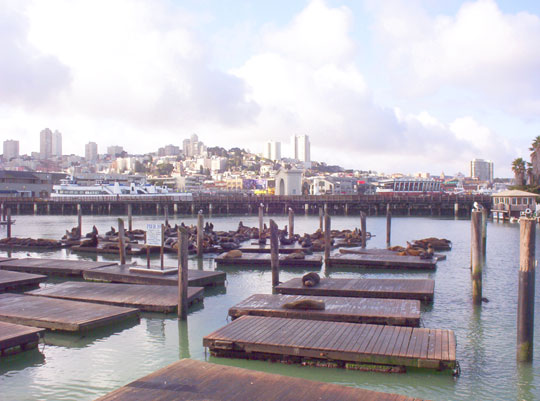
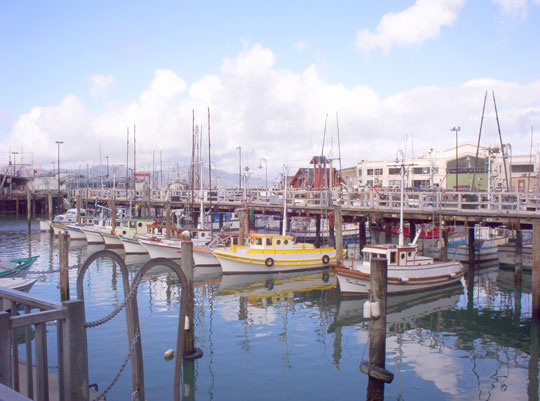
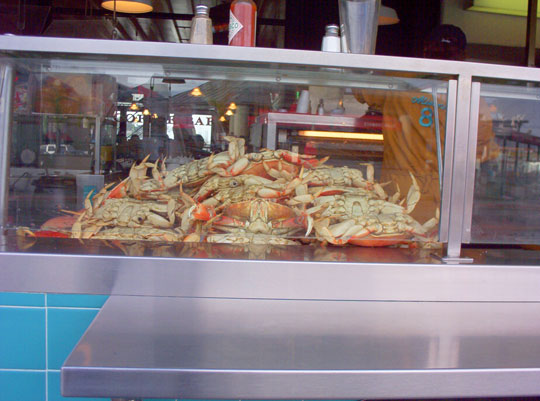
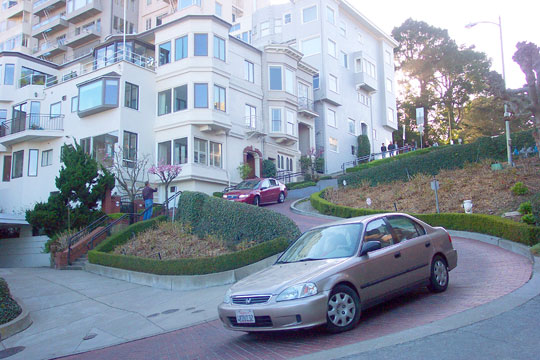
The famous Lombard Street, the worlds most crooked. It was built in 1922 in the Russian Hill district. Its crooked design was to reduce the street's natural 27° slope which was too steep for most vehicles to climb and a serious hazard to pedestrians. There is a side-street that runs off of Lombard, and several garages for local residents. |
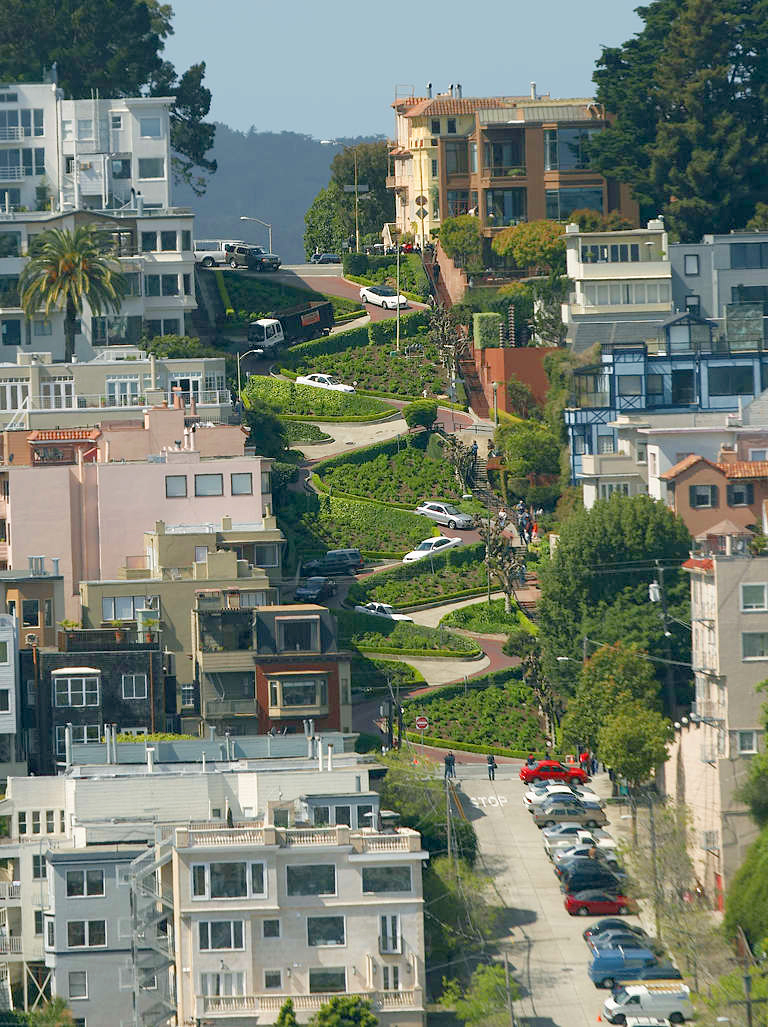
(Courtesy of Wikipedia)
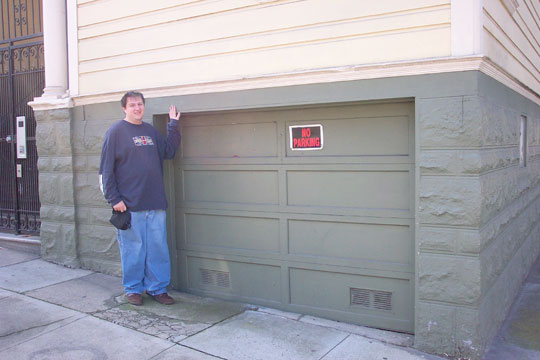
The worlds smallest garage? |
|
On our second day in the city my father and I decided to go to Alcatraz. To get to the former penitentiary you have to take a short boat ride. While Alcatraz is a national park making it free to the public, the waters surrounding Alcatraz are restricted. Thus anyone who wants to visit must take the provided ferry. The government contracts out to an independent ferry company. After Alcatraz we walked around Fisherman's Warf. |

The large building in front is the dock. When the penitentiary was in operation that building acted as apartments for the guards and also as administration offices. |

On the dock: |

-The ferry boat back to San Francisco |

-What remains of the actual prison portion of Alcatraz |

-Plant life is not taken care of and as a result everything is overgrown |


Inside the cell house; That along with increasing costs due to old age was why Alcatraz was closed in 1963. Today it is now just a tourism attraction / national park. |

-A typical prison cell, 6 feet by 6 feet |

Solitary confinement (completely in the dark when the door is closed). In solitary the guards would turn ON the lights for just one hour a day. |

Originally the only thing on the island was a lighthouse, built in 1853. Shortly after it was converted to a military prison used during the American civil war. After WWI the federal government bought the island from California in 1933. In 1934 it opened as a penitentiary, however it was not just any penitentiary. Alcatraz was a place where extreme criminals went, serial killers and the like. Above is the only remains of the Civil War prison. |
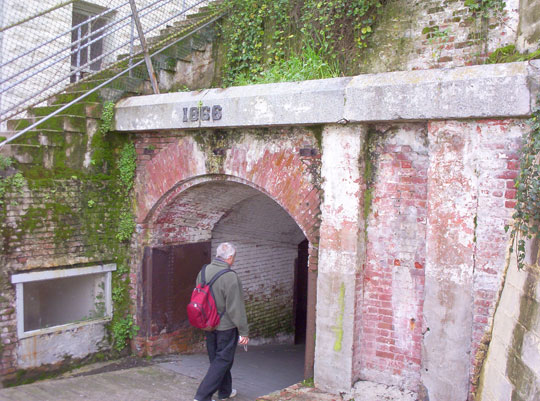
Under the civil war prison is a dungeon area, today used as a sort of museum. That is my father entering the tunnels. |

Surrounding the penitentiary grounds is the remains of the executive officers private houses. While the penitentiary was in operation, the officers and their families lived on Alcatraz. |

-The remains of the Warden's private house |
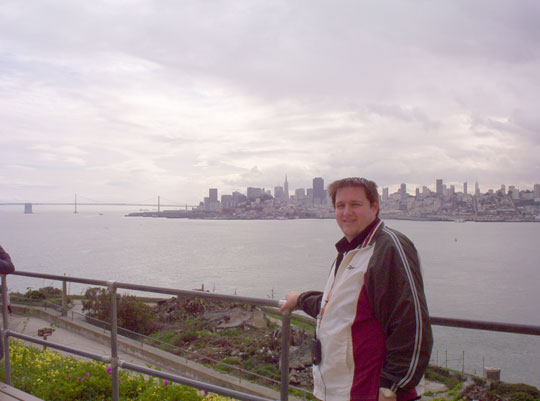
-A view of San Francisco from Alcatraz. It was a very windy day |
: After Alcatraz at
Fisherman's Warf 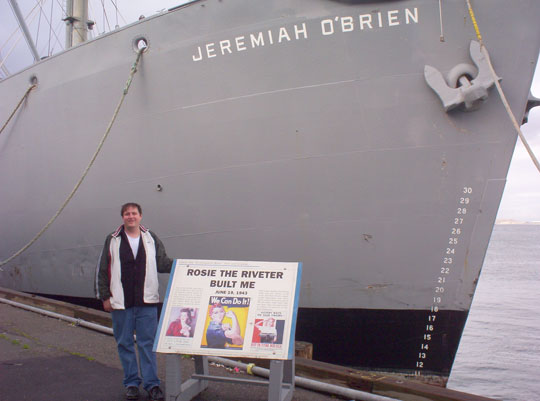
One of the attractions at Fisherman's Warf is the Jeremiah O'Brien WWII Liberty Ship. It is the only one still in operation. |


| -Another attraction is the USS Pampanito WWII Submarine |

| -Nearby the ships is an antique arcade -Here I am sizing up the romance tester |
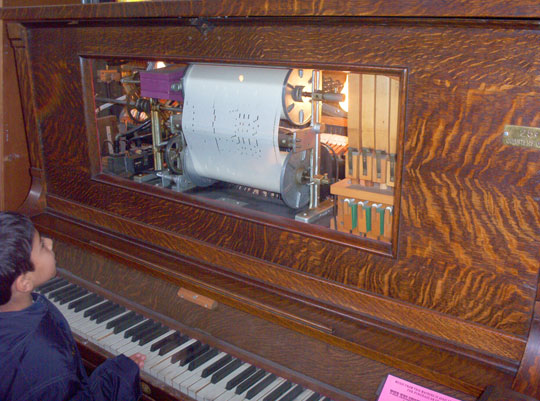
| -There are also old fashioned player piano's from the 1800's |
Day 3:
On day 3 we drove out of San Francisco across the Golden Gate Bridge. We went to the Muir Woods national park where giant redwoods grow. We went to Saucilito, a small village-like town across to bay. Then it was a drive along the coastal road to Bonita Point, the area where the San Francisco bay meets the pacific ocean.

A view of the bridge from Crissy Field park, the site of the former Air Force base by the same name. The park extends from the bridge almost all the way to Fisherman's Warf, about two miles. |


Muir Woods: just 12 miles away from San Francisco, this national park and its redwood trees are remarkable. |

In between San Francisco and Muir Woods, across the Golden Gate Bridge is the town of Saucilito. It's definitely a fishing / marina town, and Saucilito is full of house boats. No these are not boats that you can live on, they are proper houses that float. They are not very wide but tall instead, as much as 4 stories. At low tide these houses nestle into the mud. When the tide comes in they would float away if not for being anchored. They even have mailing addresses, using the dock as a street. |

-The ferry from Saucilito, around Alcatraz, to San Francisco |

When you cross the Golden Gate Bridge out of San Francisco, before you get to Saucilito, you can exit off the highway and drive the coastal road. |


The perfect place for WWII gun turrets. Several of these turrets line the coast designed to protect San Francisco from the invading Japanese. The story goes that during the war these turrets were being constructed. However before the actual guns could be mounted, the war ended. Rather than demolish them (after all, the Japanese could decide to invade again), these empty turrets remained in place for the public to walk through. |

-Along the coastal road are all
sorts |

-Being near to the ocean the winds
are |
Day 4:
Day four was another day in the city. We finished Fisherman's Warf and
then explored the city on the famous 1800's San Francisco cable cars.

Other ships at Fisherman's Warf include the Balchulatha, also known as the "Spirit of Alaska". This was a cargo ship that brought supplies to and from Alaska, to and from Australia, all from San Francisco. |

On deck of the Balchulatha: This ship was used from the 1890's through the late 1950's, it included a motor as well as sails. |

At the front of the ship is the anchor-room / crewman's quarters. Those are not shelves in the back of the picture, those are crewman's beds. In the 1890's this was considered a luxury as it was well ventilated and well naturally illuminated. |

The boats used at the Magic Kingdom are replicas of this, the "Eureka". Used as the original ferry to cross from San Francisco to Saucilito, the original cost of a one way trip was just a mere 5 cents per person, and a mere 40 cents per car. This was of course in 1890. Today the cost is $10 each way. The Eureka is a paddle-wheel ship and features two passenger decks, a restaurant and games area for the journey. |
 _
_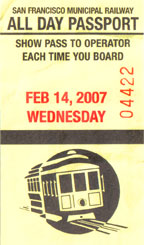
Who can go to San Francisco and not ride the cable cars? After all they are the San Francisco treat! Oops that's Rice-A-Roni. Cable cars are part of the public transportation system. If you buy all-day pass you get access to the Cable Cars, the Street Cars, the BART subway system, and the public bus system. |

Most people don't know how the Cable Cars actually work. At one end is a motor connected to a cable buried in the street. At the other end is a wheel that allows the cable to run similar to that of a moving-sidewalk. The motor is always running, meaning the cable is always moving. When the Cable Car driver wants the car to move, he pulls a lever that makes the car latch onto the cable. When latched, the cable car gets pulled along at jogging speed. When the Cable Car driver wants the car to stop he releases the latch, and pulls another lever connected to a brake. That way the Cable Car can stop on hills and can stop rather quickly. The Cable Car has been around since 1873. |
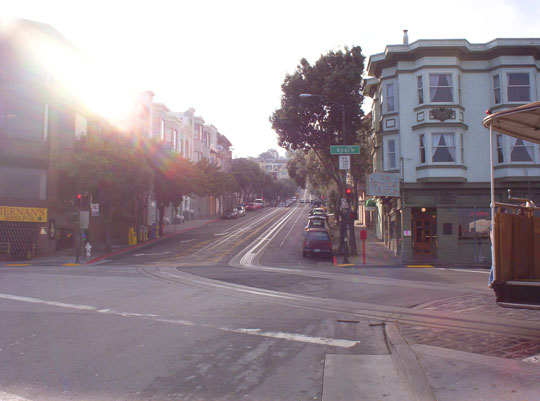
| -Hyde Street at Fisherman's Warf, one end of the only remaining Cable Car line in America |
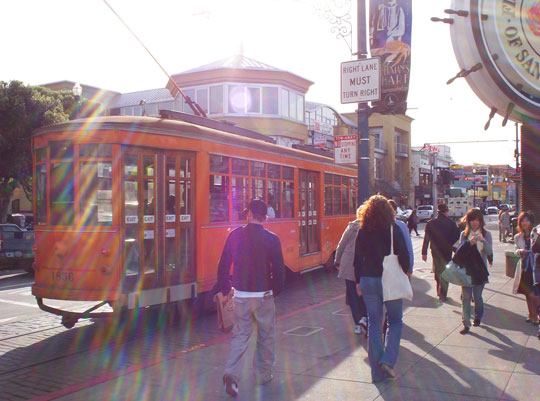
Another San Francisco treasure is the 1940's Street Car train system. Using the train lines from the old Cable Cars, these street cars are powered by electricity. Again these are part of the public transportation system. |
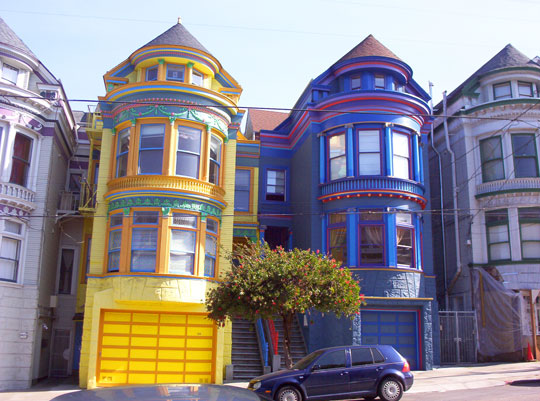
I took a picture of these houses because they look so wacky, but these colors are normal in San Francisco. Other than the color, this style of housing is prolific in San Francisco. No yards, no space in between neighbors, and circular front rooms. |
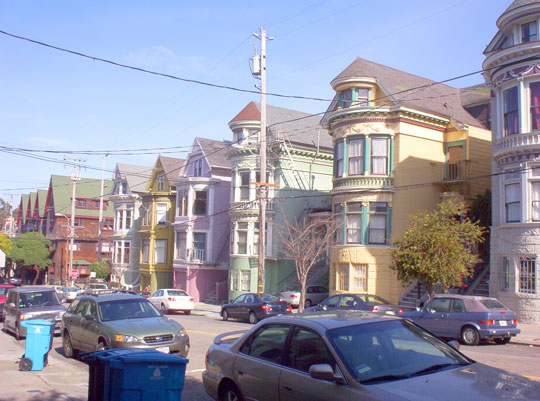

Look familiar? This is the famous street used in countless television programs, movies, etc. Remember the house from Full House? |
Day 5:
Not man pictures on this day. That's
because its hard to take
pictures while riding horseback along the beach in Half Moon By, CA.


| -Enjoy the view of this horses behind? This was my fathers doing. |

Afterwards we found a British pub in the same town. The double-decker bus is actually the smoking lounge. California like Florida has a ban on smoking in restaurants, but not in motor vehicles. Thus the owners bought this bus and made into the smoking lounge complete with plasma TV's, a full bar, and everything the pub restaurant has. |

I took this picture because the
inside of the |
Day 6:
On the day we drove back to Portland we took the long scenic route along
the ocean. When we crossed the California / Oregon border we stopped in the small town of Gold Beach.

The weather was foul and the road
a windy mess. |

| -The Oregon coast |

| -My father on the beach in Oregon
almost getting caught in the waves |
|
